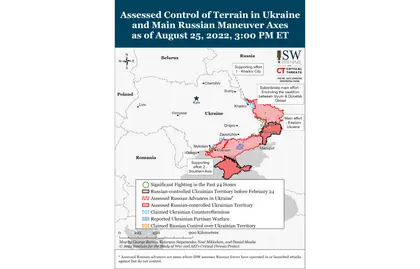Key Takeaways
- Russian forces conducted limited ground attacks northwest and northeast of Slovyansk, northeast and south of Bakhmut, and northwest of Donetsk City.
- Russian forces conducted a limited ground attack in northwestern Kharkiv Oblast.
- Russian forces conducted limited ground attacks in northwestern Kherson Oblast.
- Ukrainian forces continued to target Russian military assets and ground lines of communication (GLOCs) in Kherson Oblast.
- Russian federal subjects (regions) are continuing recruitment efforts for volunteer battalions, which are continuing to deploy to training grounds in Russia and to Ukraine.
- Russian occupation administrators are continuing to take measures to mitigate challenges to their authority and facilitate the economic and educational integration of occupied territories into the Russian system.
Russian President Vladimir Putin’s August 25 decree to increase the size of the Russian military starting in January 2023 is unlikely to generate significant combat power in the near future and indicates that Putin is unlikely to order a mass mobilization soon. The decree increases the nominal end strength of the Russian Armed Forces by 137,000 military personnel, from 1,013,628 to 1,150,628, starting on January 1, 2023.[1] The Russian military likely seeks to recover losses from its invasion of Ukraine and generate forces to sustain its operation in Ukraine. The announcement of a relatively modest (yet likely still unattainable) increased end strength target strongly suggests that Putin remains determined to avoid full mobilization. The Kremlin is unlikely to generate sufficient forces to reach an end strength of over 1,150,000 soldiers as the decree stipulates. The Russian military has not historically met its end-strength targets. It had only about 850,000 active-duty military personnel in 2022 before Russia’s full-scale invasion of Ukraine, for example, well shy of its nominal end strength target of over one million.[2]
JOIN US ON TELEGRAM
Follow our coverage of the war on the @Kyivpost_official.
Russia would likely face serious obstacles to adding large numbers of new soldiers quickly. Apart from the challenges Russian recruiters face, Russia’s net training capacity has likely decreased since February 24, since the Kremlin deployed training elements to participate in combat in Ukraine and these training elements reportedly took causalities.[3] Russia may use the fall conscription cycle in October 2022, which should bring in about 130,000 men, to replenish Russian losses, which reportedly number in the tens of thousands killed and seriously wounded. The Kremlin may alternatively use the additional end strength to formally subsume into the Russian military the forces of the Donetsk and Luhansk People’s Republics and/or the new Russian volunteer units that are not formally part of the Russian military. The net addition to Russia’s combat power in any such case would be very small.

EU Transfers €1.5 Bln Raised From Russian Assets for Ukraine
The Zaporizhzhia Nuclear Power Plant (ZNPP) disconnected from the power grid for the first time in its operational history on August 25. Ukrainian nuclear operating enterprise Energoatom reported that Russian shelling caused the disconnection by starting fires at ash pits near the Zaporizhia Thermal Power Plant (ZTPP), approximately 5km from the ZNPP.[4] Energoatom stated that the ZTPP is currently supplying the ZNPP with power and that work is ongoing to reconnect one of the ZNPP power units back to the Ukrainian power grid.[5]
Russian sources accused Ukrainian forces of firing at the ZNPP, but Russia has not provided clear evidence of Ukrainian troops striking the plant.[6] As ISW has previously reported, Ukraine’s Main Intelligence Directorate (GUR) stated that Russian troops deliberately conducted mortar strikes against the ash pits at the ZTPP.[7] The GUR also has not provided clear evidence to support its claims. The Russians’ failure to provide unequivocal evidence of the extensive shelling they accuse Ukraine of conducting is more noteworthy, however, because Russia controls the ground and could provide more conclusive evidence far more easily than Ukraine could. The GUR also reported on August 20 that Russian officials had indefinitely extended the order for Ukrainian employees of the ZNPP to stay home, and there have been no reports of any rescission of that order, which means that a portion of the ZNPP’s workforce is apparently still absent on Russian orders despite the ongoing emergency.[8] Russian forces have also heavily militarized the ZNPP since its capture, despite the fact that the facility is far from the front line and at no risk of imminent Ukrainian ground attack. This pattern of activity continues to make it far more likely that Russian forces have been responsible for kinetic attacks on and around the ZNPP than that Ukrainian forces have been.
Authors: Karolina Hird, Layne Philipson, George Barros, and Frederick W. Kagan
See the full report here.
You can also highlight the text and press Ctrl + Enter






